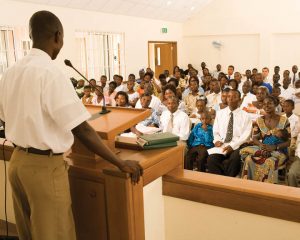A division of The Church of Jesus Christ of Latter-day Saints, whose members are sometimes called Mormons, has purchased a very large parcel of land in North Florida. While the local government officials and others are praising the deal, some bloggers have made an attempt to spark some Florida paranoia over the deal, most often because they misunderstand a number of important details about Mormonism. In this article, we will discuss the purchase and analyze the issues some journalists have misunderstood.
Background on the sale of St. Joe Co.
St. Joe Co. is selling 382,834 acres of timberland to AgReserves. Inc., which is owned by The Church of Jesus Christ of Latter-day Saints. The company paid 565 million dollars for the land, which is considered to by experts to be a typical price for such a purchase. This will mean that AgReserves will own two percent of Florida’s land. This company is a for-profit company and therefore pays property and income taxes. Although many churches consider their businesses as part of their ministry, the Mormons formed a corporation that oversees some businesses not used for religious purposes, such as this one, and they do not take non-profit status on them. The money is used to create reserves in case of emergencies, to provide wise investments that can be used in times of need, and is also used for expenses not considered appropriate for tithing money. The Mormons have strict rules about how tithing may be spent, and they consider these funds sacred.
Local leaders are pleased, because most companies would invest the land in high-impact building projects, such as condominiums or strip malls. However, AgReserves is a farming and ranching company. The previous owners were important in the conservation efforts of the state, and many leaders in the conservation movement are pleased that AgReserves, which also has a stellar history of conservation, is purchasing the land.
St. Joe will use their remaining land for their core business, which is real estate development. They once owned a million acres of land in North Florida, which, for decades, made them Florida’s largest landowner. The Mormons will now be one of the largest landowners. The land they purchased from St. Joe is all ranch and timberland, not the resorts or developed lands, nor did they buy any of St. Joe’s lands that had been scheduled for development.
Government and Environmentalist Reactions to Purchase of St. Joe Land
The Commissioner of Agriculture for Florida, Adam Putnam, released a statement about the sale:
“This transaction between two of Florida’s largest and most committed land stewards is a meaningful reminder of the economic and ecological value of agriculture in our state.
“The acquisition by AgReserves, Inc., of more than 380,000 acres in North Florida from The St. Joe Company reflects a long term investment in the state’s timber and cattle industries.
“For decades, The St. Joe Company has played an important role in conserving the landscape of Florida’s Panhandle, and AgReserves, Inc., will build on that commitment while continuing to support the local economy.
“I’m proud that a global agriculture company, like AgReserves, Inc., continues to believe in Florida as the right place to grow their business” (Statement by Commissioner Putnam on Transaction Between AgReserves, Inc., and The St. Joe Company, Florida Department of Agriculture and Consumer Services)
George Willson, of The Conservation Fund, also approved of the sale. He noted that AgReserves has a history of responsible conservation efforts on its lands. Others are more cautious, noting that the company does involve itself in cattle ranching, which many conservationists disapprove of. They are hopeful that the company will preserve the most critical portions of the land. They note that the Church tends to hold land purchases for a very long time, seeing them as an investment.
Mormons have long been careful about environmental issues, with particular emphasis on environmental issues in recent years. Brigham Young, the second Mormon prophet, is reported to have said, “It is not our privilege to waste the Lord’s substance. We may take all we need, because it is the Lord’s, but wo to him who dares to take more—for it is the Lord’s!”
In 2009, LEED Certification was obtained for the building of the Mormon-owned Family History Center in Salt Lake City, Utah. This is a very difficult certification to obtain, because it requires the building to follow strict environmental guidelines and to dramatically reduce the building’s carbon footprint. In 2010, the Church introduced its first solar-powered meetinghouse. Meetinghouses are different from temples. They are used for ordinary worship and activities and are open to the public. Since that time, more Mormon buildings are achieving LEED Certification, including for-profit businesses, such as City Creek Center, a world-class mall in Salt Lake City, Utah.
What is the Mormon Track Record on Environmental Issues?
The Mormons own Deseret Ranches, located in Central-Eastern Florida. It consists of almost 300,000 acres in three counties. Erik Jacobsen, ranch general manager and operational vice president, believes cattle and conservation can exist together if ranchers are careful and responsible. They utilize the drain and retain method for water, allowing them to preserve the water’s beneficial elements, protect underground aquifers, and forward enhanced water to waterways. They’ve created retention reservoirs that overcome the problem of rain-rich Florida’s flat land, which makes it difficult to retain the water it receives. They donated a portion of their land to create a large reservoir and sold more of it at very low rates to create additional reservoirs. This helps to create wetlands and also drains off pollution in a natural way. The ranch uses surface water rather than pumping it.
A full-time biologist monitors wildlife health and populations. To keep the population numbers at the proper size for wildlife health, they carry out hunting programs that follow the game laws and are limited to preserve species. Half of all alligator eggs are sold to other facilities to keep these numbers under control. Some adult alligators are harvested when necessary to maintain safe numbers.
The ranch also hosts a wood stork rookery. Nests of the storks are protected from predators by wide moats and by alligators that eat animals that might prey on the birds. To offset the impact of grazing land, they have created edge effects. This means that instead of clearing all the land for grazing, they create woodlands and wetlands around the grazing areas in a patchwork format, which appeals to wildlife.
Deseret Ranches has won awards for its environmental stewardship and has participated in research projects in conjunction with a local university.
Read more about the environmental issues—both for and in opposition to the ranch’s efforts—here:
Scott Taylor, Home on the Range: Mormon Church is finding new ways to preserve wetlands and wildlife, Deseret News, July 23 2013
Are the Mormons Buying St. Joe Land to Prepare for the Apocalypse?
A writer commented on the Mormon tradition of storing food for emergencies. He said it was for an apocalyptic event that would wipe out all the world’s food supplies and tied this purchase to that. However, the writer was incorrect.
Mormons are encouraged to store food for emergencies in their own homes, in countries and areas where storing food is allowed. They’re encouraged to have a supply of everyday food and other items they would need in an emergency. Life is filled with everyday emergencies.
The program was started after the Great Depression when many went hungry. Too many people had only their week’s groceries on hand, and when they lost their employment, they had nothing. Mormons store food for these types of emergencies. Those facing unemployment are comforted to know there is food in the basement and pantry, money in the bank, and no debt. (Mormons are encouraged to avoid most debt.)
Mormons also use their storage during natural disasters. During Hurricane Sandy, many Mormons were stuck in their homes for several days, and stores had very few supplies for quite some time afterwards. Those who had food, fuel, and other supplies on hand were safe and reasonably comfortable during that time, if they were able to remain in their homes.
Sometimes we’re simply too busy or too sick to shop. By having food on hand, we avoid ordering pizza or eating out too often. Having food stored also allows Mormons to keep their food costs down. Since, other than perishables, they usually have enough food to last several months, they can wait for sales before buying. Over the course of a year, this can save hundreds of dollars. If they don’t need to buy everything, they can shop at a different store each week, buying those items which are least expensive in that store.
Since Mormons are also encouraged to stay out of debt, most Mormons are fairly careful about how they spend their money, and food storage is one way to make this possible.
Are Mormons Harming Florida’s Tax base?
As mentioned earlier, Mormons divide their work into religious and for-profit categories. Some enterprises have a religious or humanitarian purpose and are non-profits. Others do not, and those are held under the for-profit arm of the church. These organizations pay property taxes and income taxes.
Concerning the Church’s farms, Gordon B. Hinckley, a late Mormon prophet, spoke on this subject while he was a counselor to the prophet of the time:
The Church does own a number of farm properties. As you know, we have some welfare properties whose produce is used to supply food for the needy. These are operated strictly for charitable purposes and legally qualify for tax-exempt status.
Then we have some commercial farm properties. I spoke earlier of the reserves of the Church. Prudent management requires that this money be put to use. In that process, we have purchased and hold some good, productive farms. They are well operated under capable management, and they yield a conservative rate of return. We have felt that good farms, over a long period, represent a safe investment where the assets of the Church may be preserved and enhanced, while at the same time they are available as an agricultural resource to feed people should there come a time of need.
Again, all such commercial properties are taxed under the government entities where they are located. Not only do they pay property taxes, but also income taxes on any profits. So it is with all of the commercial operations of the Church (Gordon B. Hinckley, The State of the Church, Ensign, May 1991).
The new land purchase in Florida belongs to the commercial arm of the Church, and so it will pay taxes, helping to support Florida’s financial needs, and it will also provide employment, as does Deseret Ranches.
Is Mormon Money from Tithing Used for Different Purposes Than This Money?
Mormons tithe ten percent of their income. It is up to them whether they feel this refers to their net or gross income, since the Lord has not given any further information than this. The practice dates back to the Book of Genesis in the Bible. In Malachi, chapter 3, God said that failing to pay tithing is robbing God. Those who tithe receive blessings from God, although those blessings might not financial in nature. There is no promise that paying tithing will make one rich financially.
The use of tithes and offerings is considered a sacred stewardship. Mormons tithe to their congregational leaders, and the money is sent to the Church’s headquarters in Utah. From there, it is sent where it is needed as determined by a committee. It is to be used only to carry out the Lord’s work, and so it helps to build and maintain temples and meetinghouses, to carry out missionary service, provide materials for managing and teaching in the Church, and to do the Lord’s work, including humanitarian work for those who are not church members.
Mormon leaders are largely lay leaders who have outside employment to support themselves. There are very few full-time positions. The president of the Church, his counselors, and the twelve apostles must serve full-time and have no other employment. Most have private sources of income—pensions or family support. Those who do not receive a modest stipend, and this is paid for from the commercial enterprises, not tithing. Tithing cannot be used for that purpose. All tithing and other funds are subjected to strict audits at several levels of church administration, first by experienced businessmen and later by independent certified public accountants.
Learn more about Mormon finances.
In short then:
Are they causing Florida to lose tax money? No—they will be paying full taxes.
Are they preparing for an apocalypse you should be aware of? No, this is just investment property.
Are they going to protect the environment? They do on their other ranch properties, so experience would suggest they are. Certainly, this will be better for the environment than building malls and condos.
Are Mormons planning to take over Florida? Presumably no one thought St. Joe’s wanted to own Florida when they were the leading land owner. Mormons are, as I said, just making a good financial investment. They’re not all moving to Florida. (With 15 million Mormons in the world, they wouldn’t all fit on the ranch, anyway.)
The Florida Paranoia is just another goofy internet rumor. Relax.
About Terrie Lynn Bittner
The late Terrie Lynn Bittner—beloved wife, mother, grandmother, and friend—was the author of two homeschooling books and numerous articles, including several that appeared in Latter-day Saint magazines. She became a member of the Church at the age of 17 and began sharing her faith online in 1992.





